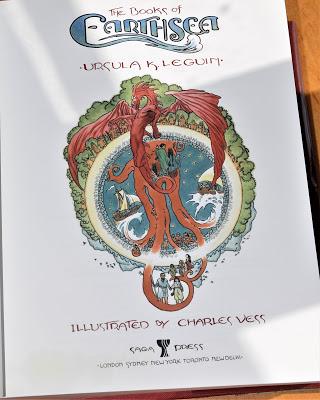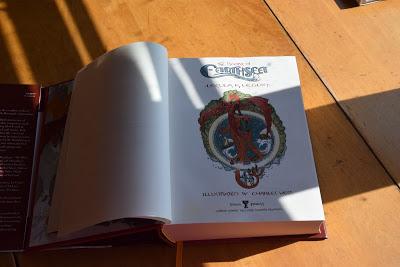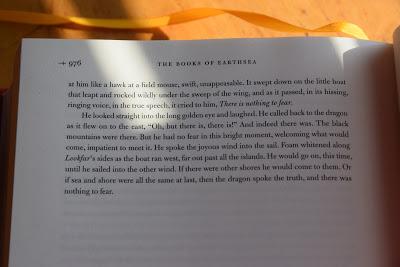
It had been almost forty years since I'd read any Le Guin but I still remembered the enchantment I felt, sailing that amazing archipelago. Then, when I began to see posts from Charles Vess--one of my favorite illustrators--about the giant edition of all Le Guin's Earthsea books that he was in the process of illustrating, The Books of Earthsea went on my wish list and, in due course, I received a copy for Christmas.

It's really big, dauntingly big. Too heavy really to read any way except sitting at a table. That seemed weird, accustomed as I am to carrying whatever I'm currently reading all around the house--kitchen counter, sofa, bed, porch. But I read it at the table -- most mornings after breakfast I'd read a few pages--five or six or till I got to a good stopping place. And I found that I really enjoyed this little ritual. Le Guin's writing is so rich that my morning reading gave me much to reflect on during the day. And I savored every sentence, rather than dashing through as I usually do. The last time it took me this long to read a book was back in high school when I took a notion to read The Divine Comedy. Then too, I read in small doses and surprised myself at how much I enjoyed the process. (The Books of Earthsea is much more accessible--just physically unwieldy.)

All six of the Earthsea novels are here, along with a handful of Earthsea short stories, and an insightful lecture, originally presented at Oxford. It's 992 pages and every one is thoughtful reading.

I love these tales of Earthsea and look forward to revisiting them. One thing that I found especially interesting was that the first three were written between 1968 and 1972 and, as LeGuin points out, have the default male hero. (He was, however, brown-skinned -- a departure for those times.) But when she started the projected fourth Earthsea book, in which the central character was a woman, Le Guin found herself blocked. Le Guin says: "I knew what men did in books, and how one wrote about them. But when it came to what women did, or how to write about it, all I had was my own experience . . . It was high time I learned to write from my own body, my own gender, in my own voice." It took about eighteen years. Years during which the feminist movement burgeoned and raised consciousnesses everywhere. Including, evidently, LeGuin's. Le Guin was in her early forties when the third book came out--and in her sixties when she picked up the thread for the last three books. The final books of the cycle deepen the stories of the characters, reflecting this new awareness of feminism, as women take their place in Earthsea lore, no longer relegated to supporting roles. I found it fascinating to trace the development of the author and her mythos. Her commentary--in the introduction, the afterwords, and the final lecture, provide a wonderful insight into the workings of an extraordinary talent. Now I'm going to have to find another book for this morning ritual. . .

